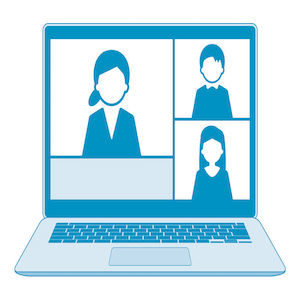By Dr. Ken Broda Bahm:

Okay, show of hands: Two weeks ago, how many of you were familiar with Zoom, Webex, GotoMeeting, and/or MS Teams? And how many of you are familiar with them today? These tools for multi-party videoconferencing over the internet have been around for years, and in some law offices have even been regularly used. But with the continued coronavirus lockdown, these tools are now seeing a renaissance, being routinely embraced for meetings, presentations, and other professional interactions. That may end up being one aspect to all of this that does not fully return to normal once all of this is over. That is, we might come out of this with the realization that our physical presence is not as important as we once thought it was.
An increasing tolerance for virtual presence could influence expectations for witness testimony. This could be the result given that there may be a span of time where work returns, but many people are still reluctant to travel or to be in large gatherings of people. In that situation, we could see more calls for communication by videoconferencing tools in trials, hearings, arbitrations, mediations and other legal meetings. In the trial context, the current Federal Rules of Civil Procedure, Rule 43 requires that witness testimony “must be taken in open court,” but includes an exception where there is “good cause and appropriate safeguards.” So that actually creates wide latitude for judges, but in my experience, live video testimony is still quite rare. But that could change, both due to necessity if the lockdowns last much longer, and due to the greater familiarity that we’re all gaining with videoconferencing in our work lives. In this blog, I’ve written quite a bit about standards for effective testimony as well as best practices for video-recorded deposition testimony, and there are already technical guidelines for presenting live-streamed testimony in court. In this post, I want to address the basic communication considerations when you’re presenting virtually, as a witness, or just as a person.
Position Yourself
One feature that generally sets the videoconference apart from the recorded deposition is the absence of a camera operator. That means that you need to be responsible for your own position, and the camera’s position. So, pay attention to what shows up in the frame. For a business meeting, it is okay to show a bit of your home (as long as what is visible is neat and in good taste), but for testimony, you want to avoid distraction, so a neutral background like a plain wall is best. Also, check the camera’s position, getting the lens as close to eye level as possible. The standard “upward gaze” from a laptop camera to the person sitting immediately in front of it is not the most flattering or the most natural way to be viewed. Finally, use physical proximity or the zoom to ensure that you are filling up most of the camera’s frame. For a witness, you will want a tighter shot, comparable to a deposition video, but given the absence of the camera operator, make sure you are able to stay centered on the screen even with a little natural movement.
And the conventional advice applies: Sit forward, place your arms on the table, and keep your shoulders straight, and your head upright. Dress professionally to fit the expectations about your role.
Look in the Right Direction
In a deposition, even one that is recorded on video, the advice I typically give is to look at questioner. The reason for that is that you want to show confidence and the “gaze aversion” of not looking at the attorney can look and feel less confident. Also, if you’re not a news anchor, it can feel artificial to be staring at a camera lens in a room full of people. But with remote testimony, there generally is no questioner, nor anyone else, physically present. So, in that situation, and in videoconferencing generally, look at the camera. If you have multiple monitors, make sure you are looking at the one that includes the camera. Don’t look generally at the screen, but at the lens itself if you can, especially when speaking. If you’re recording via a laptop, it can be hard to see the lens, so one trick is to draw an eye, punch a hole in the middle, and place that over the lens as a reminder of where to look.
Slow Down
We are all familiar with the ways conference and videoconference calls can become irritating sequence of “You go ahead…” “No, you go ahead…” and you end up sounding like lovestruck teenagers trying to decide who is going to hang up first. That problem is caused by the slight audio and video lag, as the resulting absence of the forms of nonverbal cues we would normally use to decide who has the floor. The solution isn’t perfect, but it is to slow down, allow pauses, and listen for over-talk. For the witness, the videoconferencing medium suggests the need for a few extra reminders: Only answer questions, don’t make comments, stop once the answer is given, and don’t be tempted to fill in any dead space. Proceeding slowly and thoughtfully is good advice in any case, but also helps manage the ‘lag’ in live videoconferencing technology.
______
Other Posts on Witness Testimony
- Testifying in English When It’s Not Your Native Tongue? Use That Advantage
- Avoid Gaze Aversion in Your Deposition Video